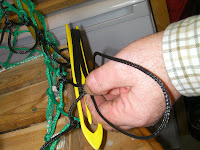 In an our competing world where chefs are trying to create new menu's and be one step ahead of each other its quite ironic quoting John Major 'Let's get back to basics' works brilliantly. Why would you want to put for example rhubarb and sherry sauce or garlic on a beautiful tasting fish like mackerel? That beats the hell out of me! In certain cases spices and herbs are used to disguise not enhance the flavour of food.Imagine going to a first class restaurant and ordering fish in sauce, garlic and sherry leeks (I actually read this on a menu). Gods knows what else! It may come a cross as creative cooking,but believe me it not. Its a terrible decimation of fantastic tasting seafood.Seafood tastes great its nutritional and healthy why spoil it.
In an our competing world where chefs are trying to create new menu's and be one step ahead of each other its quite ironic quoting John Major 'Let's get back to basics' works brilliantly. Why would you want to put for example rhubarb and sherry sauce or garlic on a beautiful tasting fish like mackerel? That beats the hell out of me! In certain cases spices and herbs are used to disguise not enhance the flavour of food.Imagine going to a first class restaurant and ordering fish in sauce, garlic and sherry leeks (I actually read this on a menu). Gods knows what else! It may come a cross as creative cooking,but believe me it not. Its a terrible decimation of fantastic tasting seafood.Seafood tastes great its nutritional and healthy why spoil it.  What a great animal a lobster is.There is are so many processes that go in to catching them because they are they are such unique animal, when it comes to cooking they should be treated properly. Believe it or not there is actually a recipe out there that involves this delicacy in a pie! What a disgrace to prime sea food.
What a great animal a lobster is.There is are so many processes that go in to catching them because they are they are such unique animal, when it comes to cooking they should be treated properly. Believe it or not there is actually a recipe out there that involves this delicacy in a pie! What a disgrace to prime sea food.The best way to cook lobster is to have a pot of boiling sea water and cook it for seven minutes per pound. You can always, which has been scientifically proved, rest the lobster for 20 minutes per pound in the freezer to let the lobster go to sleep and thus not causing distress to the animal before cooking.This makes sense because this process allows the lobster to relax and with no stress on its nervous system and it tastes sweeter.











































